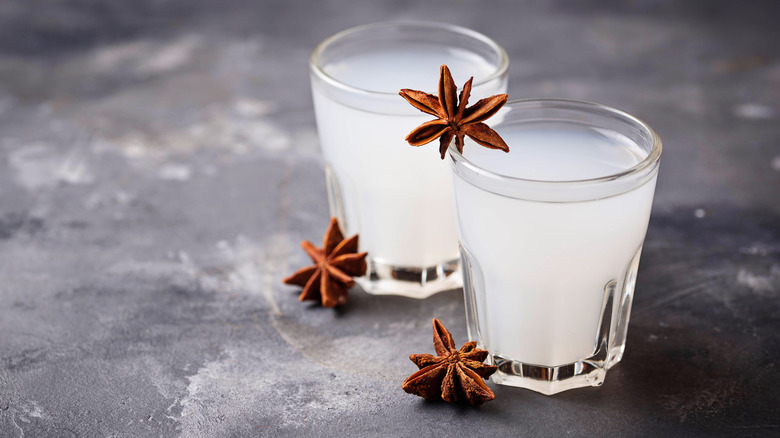What Kind Of Alcohol Is Ouzo?
If you've ever been to (or dreamt of visiting) Greece, perhaps your vision of a perfect day includes sitting by the Mediterranean Sea, eating loaded ground beef gyros, and sipping a glass of the country's national drink: ouzo. But what is this mystifying drink that's so integral to Greek culture?
Like gin, another clear alcohol, ouzo is a neutral spirit flavored with herbs, spices, and botanicals. Unlike gin, however, for which the base is typically a grain spirit, ouzo is made from grape must. (This is the term applied to the blend of fresh-pressed grapes, including juice, skins, and stems, which are left over after making wine.) It is much like grappa in Italy or raki in Turkey.
The distillation process takes place in copper stills — is sometimes repeated two to three times. Ouzo then gets a signature flavor from the addition of anise, which is its most pronounced characteristic. Other additions can range from cardamom, clove, and coriander, to fennel, wintergreen, mint, and mastiha (a type of shrub that lends piney qualities). These all can contribute complexity, aromatics, and depth to the drink's flavor profile.
Ouzo in context
Ouzo is one of a selection of drinks intended to be enjoyed before eating. Such drinks are also known as aperitifs and are different from digestifs, which are consumed post-dinner. Ouzo also shares another unique quality with other drinks, namely absinthe, pastis, and sambuca: its liquid turns a milky, cloudy white when water is added. Also known as "louche," this phenomenon is such a part of the Greek drinking experience that it's been dubbed the "ouzo effect." The cloudiness occurs because the essential oils of ouzo's herbs and spices are released when the alcohol is diluted. This helps to open up those flavorful, aromatic compounds and contributes to ouzo's complexity.
Greek law requires ouzo to be at least 37.5% alcohol by volume, but it can reach 40% or 50%. Mostly, ouzo is consumed with water or ice (often at establishments known as ouzeries), although some creative cocktails feature the spirit. You might know must-try Italian cocktails, but ouzo lends itself more to Greek variations. It even works in spritz form, with soda water and bitters for balance.
Ouzo belongs to a group of liqueurs that have a strong anise quality, including Italian sambuca and Scandinavian aquavit, so it can appeal to those familiar with these other sippers. But while it bears similarities to other styles of alcohol, ouzo is in a class of its own.

